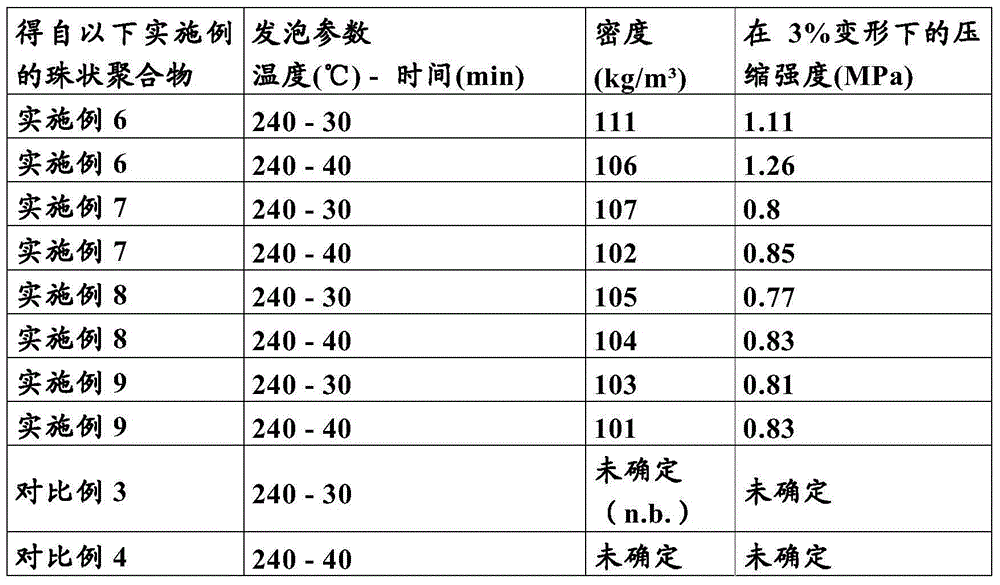Bead polymer for producing PMI foams
A polymer and foam molding technology, applied in the field of foamable bead polymers, can solve the problems of unsuitable suspension polymers
- Summary
- Abstract
- Description
- Claims
- Application Information
AI Technical Summary
Problems solved by technology
Method used
Image
Examples
Embodiment 1
[0050] Aqueous phase: 500.0 g water, 120.0 g sodium sulfate and 7.4 g Degapas 8105S; Mw: 580 000 g / mol; 13.5% strength aqueous solution
[0051] Degapas 8105S is obtained from Polyacrylic acid from Chemiewerke
[0052] Organic phase: 114 g methacrylic acid, 76 g methacrylonitrile, 10 g tert-butyl methacrylate, 0.9 g AIBN, 0.9 g dilauroyl peroxide, 0.2 g tert-butyl per-2-ethylhexanoate
[0053] Water was preliminarily placed in a 1 liter Schmizo reactor with ceramic paddle stirrer, cooler and thermocouple and sodium sulfate was dissolved therein at room temperature. The solution was heated to 75° C. and added dropwise to the monomer phase (solution of monomer and initiator) under stirring (170 rpm) within 35 minutes. The mixture was then stirred at this temperature for a further 1.5 hours. The dispersant was then added dropwise over 2 minutes. An exothermic reaction could be noticed 4 hours after the start of the reaction. The mixture was then stirred at 90 °C for an addi...
Embodiment 2
[0055] Aqueous phase: 706.50 grams of water, 176.47 grams of sodium sulfate, 42.52 grams of Degapas 8105S, 13.5% aqueous solution
[0056] Organic phase: 159.26 g methacrylic acid, 120.14 g methacrylonitrile, 14.70 g tert-butyl methacrylate, 1.28 g AIBN, 1.28 g dilauroyl peroxide, 0.29 g tert-butyl per-2-ethylhexanoate
[0057] Water was preliminarily placed in a 1 liter Schmizo reactor with ceramic paddle stirrer, cooler and thermocouple and sodium sulfate was dissolved therein (internal temperature approximately 75° C.). The ambient air in the reactor was replaced by means of dry ice. The stirring speed was 170 rpm. The organic phase was then added dropwise over 30 minutes. After a reaction time of 2 hours at an internal temperature of about 77°C, the dispersant was added. A slightly exothermic reaction was observed 4 hours after the start of the reaction. The mixed batch was stirred for 1 hour at an internal temperature of 89.5°C. Remove thermocouple. After a post rea...
Embodiment 3
[0060] Example 3: Monomer Mixture Containing Allyl Methacrylate as Crosslinker
[0061] Aqueous phase: 706.50 grams of water, 176.47 grams of sodium sulfate, 42.52 grams of Degapas 8105S; 13.5% aqueous solution
[0062] Organic phase: 164.46 g methacrylic acid, 124.23 g methacrylonitrile, 5.74 g t-butyl methacrylate, 0.294 g allyl methacrylate, 1.28 g AIBN, 1.28 g dilauroyl peroxide, 0.29 g per- tert-butyl 2-ethylhexanoate
[0063] Water was preliminarily placed in a 1 liter Schmizo reactor with ceramic paddle stirrer, cooler and thermocouple and sodium sulfate was dissolved therein (internal temperature approximately 75° C.). The ambient air in the reactor was replaced by means of dry ice. The stirring speed was 170 rpm. The organic phase was then added dropwise over 30 minutes. After a reaction time of 2 hours at an internal temperature of about 77°C, the dispersant was added. After a reaction time of 4 hours (exothermic reaction 79.9°C, bath temperature 79.2°C), the reac...
PUM
| Property | Measurement | Unit |
|---|---|---|
| diameter | aaaaa | aaaaa |
| density | aaaaa | aaaaa |
| density | aaaaa | aaaaa |
Abstract
Description
Claims
Application Information
 Login to View More
Login to View More - R&D
- Intellectual Property
- Life Sciences
- Materials
- Tech Scout
- Unparalleled Data Quality
- Higher Quality Content
- 60% Fewer Hallucinations
Browse by: Latest US Patents, China's latest patents, Technical Efficacy Thesaurus, Application Domain, Technology Topic, Popular Technical Reports.
© 2025 PatSnap. All rights reserved.Legal|Privacy policy|Modern Slavery Act Transparency Statement|Sitemap|About US| Contact US: help@patsnap.com

